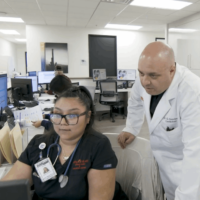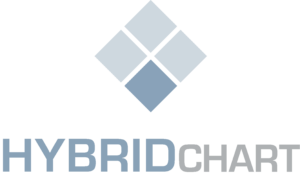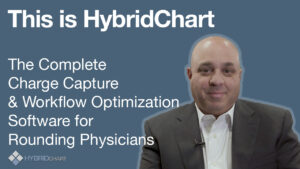As private medical practices prepare for the 2025 fiscal year, strategic budget allocation for technology and software is crucial. Modern medical practices must leverage advanced tools to enhance operational efficiency, improve patient care, and increase revenue. This blog will explore the essential technology and software needs for a contemporary medical practice, categorized into key areas: Electronic Medical Records (EMR), Billing, Scheduling, and Patient Engagement. We will also highlight the importance of SaaS platforms like HybridChart, which streamline operations and boost revenue through charge capture, discharge planning, and rounding workflow efficiencies.
1. Electronic Medical Records (EMR)
Electronic Medical Records (EMR) systems are the backbone of any modern medical practice. They provide a digital version of a patient’s paper chart, making information accessible and manageable.
Key Features and Benefits:
- Centralized Patient Information: EMR systems consolidate patient data, including medical history, diagnoses, medications, treatment plans, immunization dates, allergies, radiology images, and laboratory test results.
- Improved Accuracy and Efficiency: Digital records reduce the risk of errors associated with paper records and streamline the documentation process.
- Enhanced Coordination of Care: EMRs facilitate better communication and coordination among healthcare providers, leading to improved patient outcomes.
Budget Considerations:
- Initial Setup Costs: Allocate funds for the purchase and implementation of an EMR system.
- Training: Budget for staff training to ensure efficient use of the system.
- Maintenance and Upgrades: Plan for ongoing maintenance and periodic upgrades to keep the system up-to-date.
2. Billing and Revenue Cycle Management
Efficient billing and revenue cycle management are critical for the financial health of a medical practice. Investing in robust billing software can streamline the billing process, reduce errors, and ensure timely payments.
Key Features and Benefits:
- Automated Billing Processes: Billing software automates the generation and submission of claims, reducing administrative burden and minimizing errors.
- Revenue Cycle Management: Comprehensive solutions manage the entire revenue cycle, from patient registration and insurance verification to claim submission and payment posting.
- Analytics and Reporting: Advanced analytics provide insights into financial performance, helping practices identify areas for improvement.
Budget Considerations:
- Software Purchase or Subscription: Allocate funds for purchasing or subscribing to billing software.
- Integration with EMR: Ensure the billing software integrates seamlessly with the EMR system for efficient data flow.
- Support and Maintenance: Budget for ongoing support and maintenance to address any issues promptly.
3. Scheduling and Appointment Management
Effective scheduling and appointment management are essential for optimizing patient flow and maximizing the use of resources. Advanced scheduling software can help practices manage appointments efficiently and reduce no-shows.
Key Features and Benefits:
- Online Scheduling: Allow patients to book appointments online, providing convenience and reducing administrative workload.
- Automated Reminders: Send automated reminders via email or SMS to reduce no-show rates and improve patient attendance.
- Resource Management: Efficiently allocate resources, such as exam rooms and medical staff, to avoid overbooking and underutilization.
Budget Considerations:
- Software Costs: Allocate funds for scheduling software that meets the practice’s needs.
- Integration with EMR and Billing Systems: Ensure the scheduling software integrates with EMR and billing systems for seamless operations.
- Training and Support: Budget for staff training and ongoing support to maximize the software’s benefits.
4. Patient Engagement and Communication
Engaging patients and maintaining effective communication are vital for building strong patient relationships and improving health outcomes. Patient engagement software can enhance communication and provide patients with the tools they need to manage their health.
Key Features and Benefits:
- Patient Portals: Provide patients with secure access to their health information, appointment scheduling, and communication with healthcare providers.
- Telehealth Services: Offer virtual consultations to increase access to care and provide convenience for patients.
- Educational Resources: Share educational materials and resources to empower patients to take an active role in their health.
Budget Considerations:
- Software and Platform Costs: Allocate funds for patient engagement software and telehealth platforms.
- Integration with Existing Systems: Ensure the software integrates with EMR and other systems for a cohesive patient experience.
- Marketing and Promotion: Budget for marketing efforts to promote patient portal usage and telehealth services.
5. Operational Efficiency with SaaS Platforms
Software as a Service (SaaS) platforms play a crucial role in enhancing operational efficiency in medical practices. HybridChart is an excellent example of a SaaS platform that saves time and increases revenue through its comprehensive features.
Key Features and Benefits of HybridChart:
- Charge Capture: HybridChart’s Charge Capture feature ensures accurate and timely billing by eliminating lost charges, leading to increased revenue.
- Discharge Planning: Streamline discharge planning processes to improve patient flow and reduce readmission rates.
- Rounding Workflow Efficiencies: Enhance rounding workflows, allowing physicians to manage patient rounds more efficiently and effectively.
Budget Considerations:
- Subscription Costs: Allocate funds for subscribing to SaaS platforms like HybridChart.
- Training and Implementation: Budget for training staff on the use of the platform and its features.
- Return on Investment: Consider the potential return on investment from increased revenue and operational efficiencies.
In 2025, private medical practices must prioritize budget allocation for essential technology and software to operate effectively. By investing in EMR systems, billing and revenue cycle management software, scheduling and appointment management tools, patient engagement platforms, and SaaS solutions like HybridChart, practices can enhance operational efficiency, improve patient care, and increase revenue. Thoughtful budget planning and strategic investments in these areas will position medical practices for success in the coming year.





